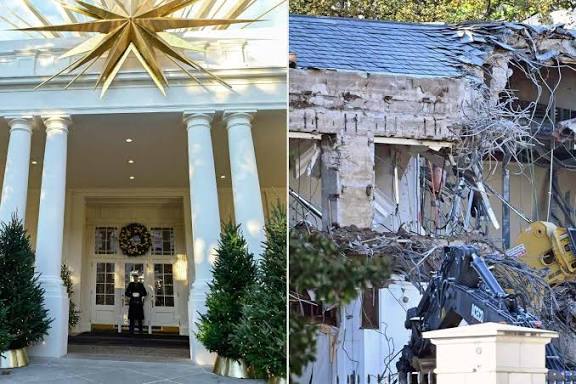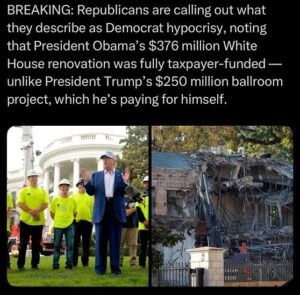obama white house renovation Trump: cost 376 million,before and after

Trump’s comments on Wednesday put the cost of demolition at $300 million, increasing the cost from $250 million. Today we will discuss about obama white house renovation Trump: cost 376 million,before and after
obama white house renovation Trump: cost 376 million,before and after
The White House, located at 1600 Pennsylvania Avenue, is one of the most iconic buildings in the world — a symbol of the American presidency and a living museum of national history. Over more than two centuries, it has undergone numerous restorations, expansions, and technological upgrades to keep it functional, secure, and reflective of its time.
Two recent chapters in its renovation history stand out. The first involves a massive infrastructure overhaul initiated during the Barack Obama administration, often cited with an estimated cost of around $376 million. The second is the ambitious Donald Trump–era ballroom project, a proposed addition expected to cost around $200 to $250 million, dramatically changing the White House’s East Wing.
This article explores both projects in depth — what was done, why, how much it cost, and what the White House looked like before and after.
The Obama-Era Renovation: The $376 Million Infrastructure Overhaul

What the $376 Million Was For
During the Obama presidency, reports began to circulate about a large-scale White House infrastructure project estimated at roughly $376 million. This renovation was not about luxury or visible redesigns but about essential maintenance and modernization — ensuring the 200-year-old building could continue to serve as the seat of executive power safely and efficiently.
The majority of the spending covered:
-
Replacement of outdated electrical wiring dating back decades.
-
Upgrades to HVAC systems (heating, ventilation, and air conditioning) to improve energy efficiency.
-
Modernization of fire safety systems and security infrastructure.
-
Structural reinforcement of aging foundations and ceilings.
-
Restoration of historic finishes damaged by age and constant use.
This was the kind of work that most visitors would never see but without which the White House could not safely operate.
Why Such a Massive Renovation Was Needed
The White House has undergone several major overhauls throughout its history — most famously under Harry Truman between 1948 and 1952 when the entire interior was rebuilt due to structural failure. By the early 2010s, engineers found that many systems installed during earlier renovations were again reaching the end of their life cycles.
Electrical wiring was overloaded by modern technology, plumbing lines had aged, and the climate-control systems were decades old. The growing security demands of a post-9/11 world also required rewiring and reinforcement.
Thus, the Obama administration approved a long-term project aimed at rebuilding the infrastructure of the White House from within — a “renovation you can’t see.”
What Was Actually Done
Contrary to social media rumors about lavish redecorations, most of the spending focused on hidden but vital upgrades. However, there were a few aesthetic and restoration projects as well:
-
Restoration of historic furniture, including the early 19th-century Bellangé suite in the Blue Room.
-
Refinishing of brass, woodwork, and lighting fixtures across state rooms.
-
New carpets and draperies in public areas such as the East Room and State Dining Room.
-
HVAC upgrades across the building, ensuring year-round climate control.
-
Repainting and refinishing of high-traffic public areas used for state visits and media events.
Overall, this was a project designed to keep the “People’s House” functioning for another generation, with preservation of history and efficiency as top priorities.
Funding and Accountability
The Obama-era renovation costs were largely covered by federal appropriations through the General Services Administration (GSA) and the Executive Residence budget. Unlike later private-funded efforts, these renovations were standard government expenditures for maintaining federal property.
While the figure of $376 million circulated widely, it represented a multi-year estimate, not necessarily a single lump sum spent in one fiscal year. Nevertheless, the total cost reflected a significant national investment in the continued health of one of the world’s most recognized symbols.
The Public Reaction
Because the project was mostly technical and invisible, the Obama-era renovations didn’t attract significant controversy. There were no dramatic architectural changes, and the spending was justified as essential maintenance rather than luxury.
Still, some critics argued that the cost seemed high for “unseen repairs.” Supporters countered that failure to act would have resulted in far greater expenses later, especially if mechanical systems failed or the structure suffered damage.
In short, the Obama renovation was about preservation, not presentation — the foundation upon which future upgrades, including Trump’s, would rest.
The Trump-Era Renovation: The $200–$250 Million Ballroom Project
A New Vision for the East Wing
When Donald Trump returned to office, he proposed an eye-catching addition to the White House complex: a massive new ballroom to be constructed in or alongside the East Wing. The planned project, according to public reports and statements, would cover approximately 90,000 square feet — enough to host large gatherings, state dinners, and ceremonial events that previously required temporary tents on the South Lawn.
The proposed ballroom, with a seating capacity of up to 650 guests, would give the White House a permanent, grand event space on par with European palaces and luxury presidential residences around the world.
Projected Cost and Funding
The ballroom’s cost was initially pegged at around $200 million, but later estimates placed it closer to $250 million or higher, depending on design changes and materials.
What set this project apart from Obama’s renovation was the funding structure. The Trump White House claimed that the project would be entirely financed by private donations rather than taxpayer money. Wealthy contributors and foundations were expected to underwrite the costs as part of a legacy initiative.
Supporters hailed this as a responsible approach that avoided burdening taxpayers. Critics, however, raised concerns about transparency, potential conflicts of interest, and whether private funding for a government building might create future ethical complications.
Before and After: The East Wing Transformation
Before:
-
The East Wing, first added in 1902 and expanded in 1942, served primarily as office space for the First Lady, the social secretary, and various support staff.
-
Architecturally, it was functional but understated, with corridors and offices connected by the East Colonnade leading toward the Residence.
-
Large events such as state dinners were usually held in the East Room or in temporary outdoor setups.
After (Projected):
-
The East Wing would house a grand ballroom with soaring ceilings, chandeliers, and possibly even retractable glass walls or advanced lighting systems.
-
The design, while modernized, was expected to match the neoclassical aesthetic of the original White House architecture.
-
The new space would allow the President to host large events indoors year-round, transforming the East Wing from a working office space into a major ceremonial area.
Public Reaction and Controversy
The Trump ballroom plan quickly drew mixed reactions:
-
Supporters praised it as visionary, arguing that the White House needed a permanent event space capable of accommodating state banquets, cultural galas, and diplomatic receptions without constant temporary structures.
-
Critics called it extravagant and unnecessary, questioning whether a $200–$250 million ballroom was a wise use of funds — even if privately financed — during a time of broader fiscal challenges.
-
Preservationists worried that demolishing or altering the historic East Wing would compromise the integrity of the original architecture.
The debate extended beyond politics to questions about heritage, aesthetics, and presidential legacy.
Comparing the Obama and Trump Projects
| Aspect | Obama Era | Trump Era |
|---|---|---|
| Estimated Cost | $376 million | $200–$250 million |
| Primary Purpose | Infrastructure modernization (HVAC, wiring, fire safety) | Construction of new 90,000 sq ft ballroom |
| Funding Source | Federal appropriations | Claimed private donations |
| Scope | Internal systems; mostly invisible | Major new structure; highly visible |
| Nature of Work | Technical and structural maintenance | Architectural expansion and redesign |
| Public Reaction | Moderate; seen as necessary upkeep | Controversial; seen by some as luxury |
| Outcome | Improved functionality and safety | Pending project, new event capacity |
| Symbolism | Preservation and maintenance | Expansion and grandeur |
The difference in tone is striking. Obama’s renovation was about keeping the White House functional. Trump’s is about reimagining its grandeur and legacy.
Why the Costs Can’t Be Directly Compared
While both projects involve large sums, they are fundamentally different in nature:
-
Infrastructure vs. Architecture:
The Obama renovation dealt with essential internal systems — “guts” of the building — while the Trump project is an architectural expansion adding new space and amenities. -
Functionality vs. Symbolism:
Obama’s renovations were functional and necessary; Trump’s ballroom is symbolic, focused on presentation, legacy, and hosting capacity. -
Taxpayer vs. Private Funding:
Obama’s project used federal funds, subject to standard oversight. Trump’s is privately financed, raising questions about transparency and donor influence. -
Public Visibility:
Obama’s work was invisible to the public eye; Trump’s will be one of the most visible additions in White House history. -
Historical Impact:
Both projects, however, leave a mark — Obama’s in preserving the building’s function, Trump’s in reshaping its architecture.
Historical Context: A Tradition of Presidential Renovations
The White House has been rebuilt or renovated many times:
-
Theodore Roosevelt (1902) modernized and expanded the West Wing.
-
Harry Truman (1948–1952) gutted and rebuilt the interior completely.
-
John F. Kennedy (1961–1963) oversaw an elegant interior restoration led by Jacqueline Kennedy.
-
Bill Clinton and George W. Bush introduced new security and technology upgrades.
-
Barack Obama modernized infrastructure for safety and efficiency.
-
Donald Trump is poised to make one of the most dramatic architectural additions in modern times.
Each era leaves a physical and symbolic mark on the “People’s House,” reflecting the priorities and aesthetics of its occupant.
The Bigger Picture: Preservation, Politics, and Legacy
Preservation vs. Progress
The challenge of maintaining a 200-year-old presidential residence lies in balancing preservation with modernization. Every renovation risks altering history, yet inaction risks decay. The Obama and Trump projects represent two ends of that balance: unseen preservation versus bold expansion.
Politics of Renovation
Every major White House renovation inevitably becomes political. Under Obama, critics focused on the size of the budget. Under Trump, debate centers on the necessity and symbolism of luxury. In both cases, spending on the White House reflects broader discussions about transparency, priorities, and presidential image.
Legacy
Both presidents’ projects contribute differently to the White House’s long-term story:
-
Obama’s renovations ensured that the building remained safe, efficient, and sustainable for future leaders.
-
Trump’s ballroom project, if completed, would permanently reshape the White House campus, adding a venue likely to host future presidents’ major events.
Regardless of public opinion, each project demonstrates how presidents inevitably leave their mark — not only in policy but in stone, steel, and structure.
Conclusion
From Barack Obama’s $376 million infrastructure overhaul to Donald Trump’s $250 million ballroom project, the White House has seen two very different kinds of transformation in the 21st century.
Obama’s renovations were quiet, technical, and essential — the kind of work that keeps the heart of the building beating. Trump’s ballroom proposal is bold, visible, and emblematic — aimed at grandeur, scale, and legacy.
Both serve a purpose. One preserves the history; the other redefines it.
The contrast between the two highlights an ongoing truth: the White House is not just a symbol of power, but a living, evolving structure — shaped by each generation, reflecting both practicality and personality. Whether behind the walls or beneath a new chandelier, every renovation tells a story about the presidency and the era it represents.
How useful was this post?
Click on a star to rate it!
Average rating 0 / 5. Vote count: 0
No votes so far! Be the first to rate this post.
About the Author
usa5911.com
Administrator
Hi, I’m Gurdeep Singh, a professional content writer from India with over 3 years of experience in the field. I specialize in covering U.S. politics, delivering timely and engaging content tailored specifically for an American audience. Along with my dedicated team, we track and report on all the latest political trends, news, and in-depth analysis shaping the United States today. Our goal is to provide clear, factual, and compelling content that keeps readers informed and engaged with the ever-changing political landscape.



